CHA101L Post-Quiz 7
5.0(1)
Card Sorting
1/48
Earn XP
Study Analytics
Name | Mastery | Learn | Test | Matching | Spaced |
|---|
No study sessions yet.
49 Terms
1
New cards
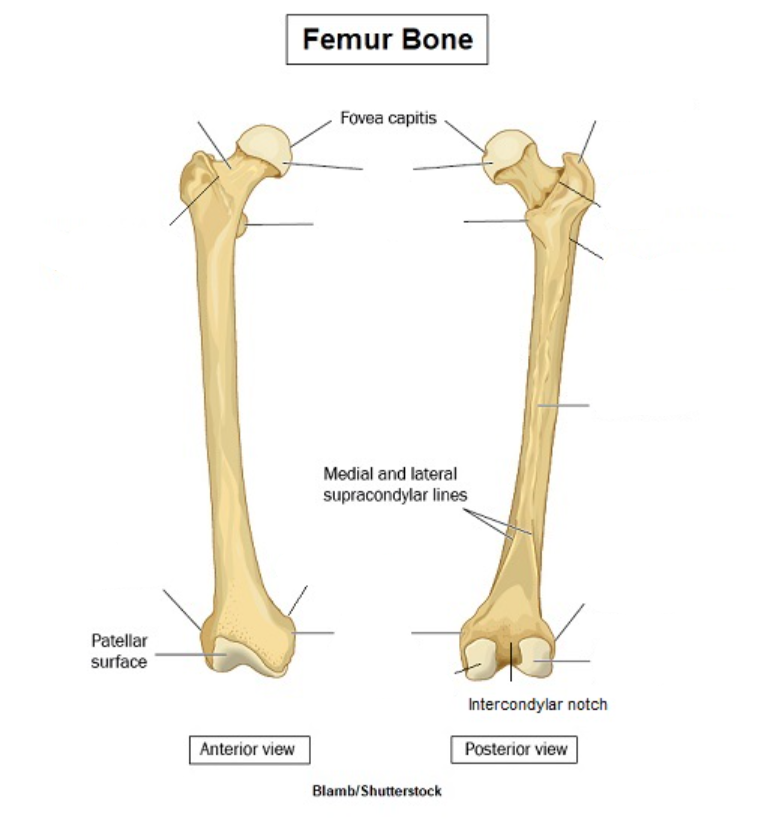
Identify
* Left: Neck, Intertrochanteric line, Lateral epicondyle
* Middle: Head, Lesser trochanter, Adductor tubercle, Medial epicondyle, Medial condyle
* Right: Greater trochanter, Intertrochanteric crest, Gluteal tuberosity, Linea aspera, Lateral epicondyle, Lateral condyle
* Middle: Head, Lesser trochanter, Adductor tubercle, Medial epicondyle, Medial condyle
* Right: Greater trochanter, Intertrochanteric crest, Gluteal tuberosity, Linea aspera, Lateral epicondyle, Lateral condyle
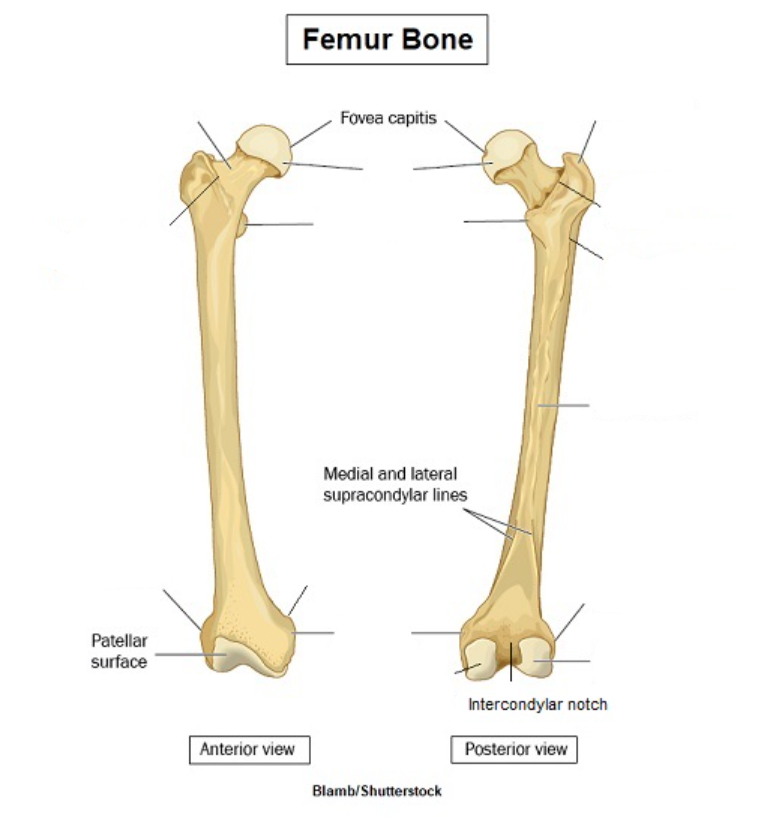
2
New cards
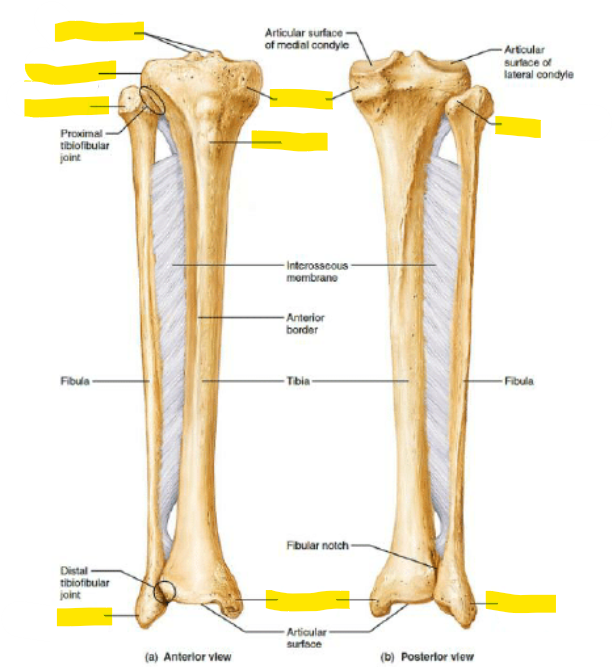
Identify
* Left: Intercondylar eminence, Lateral condyle, Head (fibula), Lateral malleolus (fibula)
* Middle: Medial condyle, Tibial tuberosity, Medial malleolus
* Right: Head (fibula), Lateral malleolus (fibula)
* Middle: Medial condyle, Tibial tuberosity, Medial malleolus
* Right: Head (fibula), Lateral malleolus (fibula)

3
New cards
Gluteus maximus
* Origin: iliac crest, sacrum, sacrotuberous ligament
* Insertion: iliotibial tract, gluteal tuberosity, femoral shaft
* Main actions (on thigh): extension, lateral rotation
* Innervation: inferior gluteal
* Insertion: iliotibial tract, gluteal tuberosity, femoral shaft
* Main actions (on thigh): extension, lateral rotation
* Innervation: inferior gluteal
4
New cards
Gluteus medius
* Origin: ilium external surface
* Insertion: greater trochanter
* Main actions (on thigh): abduction, medial rotation; prevents pelvic tilt with gait
* Innervation: superior gluteal
* Insertion: greater trochanter
* Main actions (on thigh): abduction, medial rotation; prevents pelvic tilt with gait
* Innervation: superior gluteal
5
New cards
Gluteus minimus
* Origin: ilium external surface
* Insertion: greater trochanter
* Main actions (on thigh): abduction, medial rotation; prevents pelvic tilt with gait
* Innervation: superior gluteal
* Insertion: greater trochanter
* Main actions (on thigh): abduction, medial rotation; prevents pelvic tilt with gait
* Innervation: superior gluteal
6
New cards
Tensor fasciae latae
* Origin: iliac crest
* Insertion: iliotibial tract
* Main actions (on thigh): stabilizes knee joint in extension
* Innervation: superior gluteal
* Insertion: iliotibial tract
* Main actions (on thigh): stabilizes knee joint in extension
* Innervation: superior gluteal
7
New cards
Piriformis
* Origin: sacrum, sacrotuberous ligament
* Insertion: greater trochanter
* Main actions: laterally rotate thigh and stabilize femoral head in acetabulum
* Insertion: greater trochanter
* Main actions: laterally rotate thigh and stabilize femoral head in acetabulum
8
New cards
Gemellus superior
* Origin: ischial spine
* Insertion: greater trochanter
* Main actions: laterally rotate thigh and stabilize femoral head in acetabulum
* Insertion: greater trochanter
* Main actions: laterally rotate thigh and stabilize femoral head in acetabulum
9
New cards
Obturator internus
* Origin: inner surface of obturator foramen
* Insertion: greater trochanter
* Main actions: laterally rotate thigh and stabilize femoral head in acetabulum
* Insertion: greater trochanter
* Main actions: laterally rotate thigh and stabilize femoral head in acetabulum
10
New cards
Gemellus inferior
* Origin: ischial tuberosity
* Insertion: greater trochanter
* Main actions: laterally rotate thigh and stabilize femoral head in acetabulum
* Insertion: greater trochanter
* Main actions: laterally rotate thigh and stabilize femoral head in acetabulum
11
New cards
Obturator externus
* Origin: outer margins of obturator foramen
* Insertion: greater trochanter
* Main actions: laterally rotate thigh and stabilize femoral head in acetabulum
* Insertion: greater trochanter
* Main actions: laterally rotate thigh and stabilize femoral head in acetabulum
12
New cards
Quadratus femoris
* Origin: ischial tuberosity
* Insertion: intertrochanteric crest of femur
* Main actions: laterally rotate thigh and stabilize femoral head in acetabulum
* Insertion: intertrochanteric crest of femur
* Main actions: laterally rotate thigh and stabilize femoral head in acetabulum
13
New cards
Trendelenburg gait
* Abnormal gait resulting from defective hip abductor mechanism (gluteus medias or minimus)
14
New cards
Piriformis syndrome
* Piriformis muscle compresses the sciatic nerve
15
New cards
Biceps femoris long head
* Origin: ischial tuberosity
* Insertion: fibular head
* Main actions: extends thigh, flexes leg
* Innervation: tibial nerve
* Insertion: fibular head
* Main actions: extends thigh, flexes leg
* Innervation: tibial nerve
16
New cards
Biceps femoris short head
* Origin: linea aspera
* Insertion: fibular head
* Main actions: flexes leg
* Innervation: common fibular nerve
* Insertion: fibular head
* Main actions: flexes leg
* Innervation: common fibular nerve
17
New cards
Semitendinosus
* Origin: ischial tuberosity
* Insertion: proximal medial shaft of tibia
* Main actions: extends thigh, flexes leg
* Innervation: tibial nerve
* Insertion: proximal medial shaft of tibia
* Main actions: extends thigh, flexes leg
* Innervation: tibial nerve
18
New cards
Semimembranosus
* Origin: ischial tuberosity
* Insertion: tibia medial condyle
* Main actions: extends thigh, flexes leg
* Innervation: tibial nerve
* Insertion: tibia medial condyle
* Main actions: extends thigh, flexes leg
* Innervation: tibial nerve
19
New cards
Sartorius
* Origin: ASIS
* Insertion: proximal medial shaft of tibia
* Main actions: flexes thigh, laterally rotates thigh, flexes leg
* Innervation: femoral nerve
* Insertion: proximal medial shaft of tibia
* Main actions: flexes thigh, laterally rotates thigh, flexes leg
* Innervation: femoral nerve
20
New cards
Quadriceps femoris - rectus femoris
* Origin: AIIS
* Insertion: patellar ligament to tibial tuberosity
* Main actions: flexes thigh, extends leg
* Innervation: femoral nerve
* Insertion: patellar ligament to tibial tuberosity
* Main actions: flexes thigh, extends leg
* Innervation: femoral nerve
21
New cards
Quadriceps femoris - vastus lateralis
* Origin: greater trochanter
* Insertion: patellar ligament to tibial tuberosity
* Main actions: extends leg
* Innervation: femoral nerve
* Insertion: patellar ligament to tibial tuberosity
* Main actions: extends leg
* Innervation: femoral nerve
22
New cards
Quadriceps femoris - vastus medialis
* Origin: intertrochanteric line
* Insertion: patellar ligament to tibial tuberosity
* Main actions: extends leg
* Innervation: femoral nerve
* Insertion: patellar ligament to tibial tuberosity
* Main actions: extends leg
* Innervation: femoral nerve
23
New cards
Quadriceps femoris - vastus intermedius
* Origin: anterior femoral shaft
* Insertion: patellar ligament to tibial tuberosity
* Main actions: extends leg
* Innervation: femoral nerve
* Insertion: patellar ligament to tibial tuberosity
* Main actions: extends leg
* Innervation: femoral nerve
24
New cards
Iliopsoas
* Origin: lumbar vertebra, iliac crest and fossa
* Insertion: lesser trochanter of femur
* Main actions: flexes thigh (powerfully)
* Insertion: lesser trochanter of femur
* Main actions: flexes thigh (powerfully)
25
New cards
Pectineus
* Origin: superior pubic ramus
* Insertion: pectineal line of femur
* Main actions: adducts thigh, some flexion
* Innervation: obturator nerve
* Insertion: pectineal line of femur
* Main actions: adducts thigh, some flexion
* Innervation: obturator nerve
26
New cards
Adductor brevis
* Origin: ischiopubic ramus
* Insertion: linea aspera (top 1/3)
* Main actions: adducts thigh, some flexion
* Innervation: obturator nerve
* Insertion: linea aspera (top 1/3)
* Main actions: adducts thigh, some flexion
* Innervation: obturator nerve
27
New cards
Adductor longus
* Origin: crest of pubic symphysis
* Insertion: linea aspera (middle 1/3)
* Main actions: adducts thigh, some flexion
* Innervation: obturator nerve
* Insertion: linea aspera (middle 1/3)
* Main actions: adducts thigh, some flexion
* Innervation: obturator nerve
28
New cards
Adductor magnus - adductor portion
* Origin: ischiopubic ramus
* Insertion: linea aspera (lower 1/3)
* Main actions: adducts thigh
* Innervation: obturator nerve
* Insertion: linea aspera (lower 1/3)
* Main actions: adducts thigh
* Innervation: obturator nerve
29
New cards
Adductor magnus - hamstring portion
* Origin: ischial tuberosity
* Insertion: adductor tubercle of femur
* Main actions: extends thigh
* Innervation: tibial nerve
* Insertion: adductor tubercle of femur
* Main actions: extends thigh
* Innervation: tibial nerve
30
New cards
Gracilis
* Origin: symphysis pubis
* Insertion: proximal medial shaft of tibia
* Main actions: adducts thigh, slight leg flexion
* Insertion: proximal medial shaft of tibia
* Main actions: adducts thigh, slight leg flexion
31
New cards
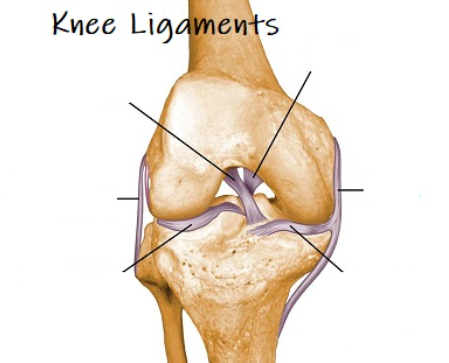
Identify
* Left: ACL, LCL, lateral meniscus
* Right: PCL, MCL, medial meniscus
* Right: PCL, MCL, medial meniscus
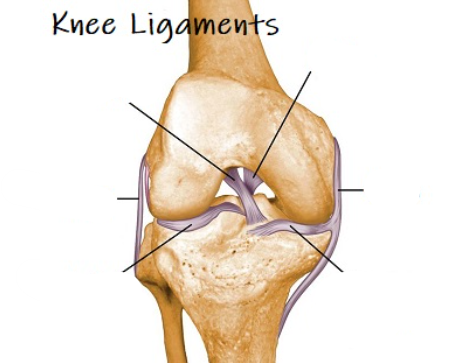
32
New cards
Valgus stress test
* Test for MCL injury
* Move knee medially and leg laterally
* Move knee medially and leg laterally
33
New cards
Varus stress test
* Test for LCL injury
* Move knee laterally and leg medially
* Move knee laterally and leg medially
34
New cards
Anterior drawer test
* Test for ACL injury
* Flex knee 90 degrees, then pull leg anteriorly (injury if there is excessive anterior movement)
* Flex knee 90 degrees, then pull leg anteriorly (injury if there is excessive anterior movement)
35
New cards
Lachman test
* Test for ACL injury
* Flex knee 15-20 degrees, then pull leg anteriorly (injury if there is excessive anterior movement)
* Flex knee 15-20 degrees, then pull leg anteriorly (injury if there is excessive anterior movement)
36
New cards
Posterior drawer test
* Test for PCL injury
* Flex knee 90 degrees, then push tibia (injury if there is excessive posterior movement)
* Can also hold leg up and let gravity do work (will see indentation in the knee if PCL injury present)
* Flex knee 90 degrees, then push tibia (injury if there is excessive posterior movement)
* Can also hold leg up and let gravity do work (will see indentation in the knee if PCL injury present)
37
New cards
McMurray test
* Test for meniscus injury
38
New cards
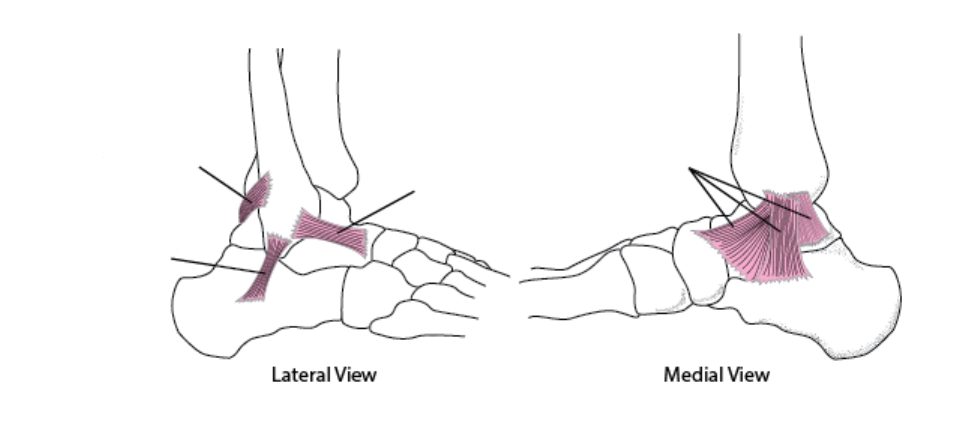
Identify
* Left: Posterior talofibular ligament, Calcaneofibular ligament
* Middle: Anterior talofibular ligament, Medial collateral (deltoid) ligament
* Middle: Anterior talofibular ligament, Medial collateral (deltoid) ligament
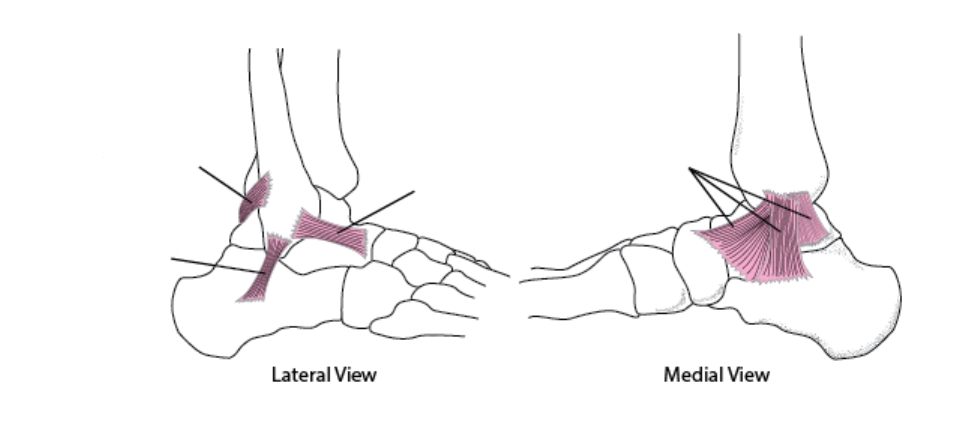
39
New cards
Tibialis anterior
* Origin: lateral condyle and lateral surface of the tibia
* Insertion: base of first metatarsal
* Main actions: dorsiflexes ankle, inverts foot
* Innervation: deep fibular nerve
* Insertion: base of first metatarsal
* Main actions: dorsiflexes ankle, inverts foot
* Innervation: deep fibular nerve
40
New cards
Extensor hallucis longus
* Origin: anterior fibula and interosseous membrane
* Insertion: dorsal aspect of distal phalanx of great toe
* Main actions: extends great toe, dorsiflexes ankle
* Innervation: deep fibular nerve
* Insertion: dorsal aspect of distal phalanx of great toe
* Main actions: extends great toe, dorsiflexes ankle
* Innervation: deep fibular nerve
41
New cards
Extensor digitorum longus
* Origin: anterior fibula and interosseous membrane
* Insertion: middle and distal phalanges digits 2-5
* Main actions: extends digits 2-5, dorsiflexes ankle
* Innervation: deep fibular nerve
* Insertion: middle and distal phalanges digits 2-5
* Main actions: extends digits 2-5, dorsiflexes ankle
* Innervation: deep fibular nerve
42
New cards
Fibularis longus
* Origin: head and superolateral fibula
* Insertion: base of first metatarsal
* Main actions: everts foot, plantarflexes foot
* Innervation: superficial fibular nerve
* Insertion: base of first metatarsal
* Main actions: everts foot, plantarflexes foot
* Innervation: superficial fibular nerve
43
New cards
Fibularis brevis
* Origin: inferolateral fibula
* Insertion: base of 5th metatarsal
* Main actions: everts foot, plantarflexes foot
* Innervation: superficial fibular nerve
* Insertion: base of 5th metatarsal
* Main actions: everts foot, plantarflexes foot
* Innervation: superficial fibular nerve
44
New cards
Gastrocnemius
* Origin: lateral and medial femoral condyles
* Insertion: calcaneal tendon
* Main actions: plantarflexes ankle, flexes leg
* Innervation: tibial nerve
* Insertion: calcaneal tendon
* Main actions: plantarflexes ankle, flexes leg
* Innervation: tibial nerve
45
New cards
Soleus
* Origin: posterior fibular head, tibial soleal line
* Insertion: calcaneal tendon
* Main actions: plantarflexes ankle
* Innervation: tibial nerve
* Insertion: calcaneal tendon
* Main actions: plantarflexes ankle
* Innervation: tibial nerve
46
New cards
Plantaris
* Origin: lateral supracondylar line
* Insertion: calcaneal tendon
* Main actions: weakly assists gastrocnemius
* Innervation: tibial nerve
* Insertion: calcaneal tendon
* Main actions: weakly assists gastrocnemius
* Innervation: tibial nerve
47
New cards
Flexor hallucis longus
* Origin: posterior fibula, interosseous membrane
* Insertion: base of distal phalanx of great toe
* Main actions: flexes great toe, plantarflexes ankle
* Innervation: tibial nerve
* Insertion: base of distal phalanx of great toe
* Main actions: flexes great toe, plantarflexes ankle
* Innervation: tibial nerve
48
New cards
Flexor digitorum longus
* Origin: posterior tibia and fibula
* Insertion: distal phalanges 2-5
* Main actions: flexes digits 2-5, plantarflexes ankle
* Innervation: tibial nerve
* Insertion: distal phalanges 2-5
* Main actions: flexes digits 2-5, plantarflexes ankle
* Innervation: tibial nerve
49
New cards
Tibialis posterior
* Origin: interosseous membrane, posterior surface of tibia and fibula
* Insertion: navicular, cuneiform, cuboid, bases of metatarsals 2-4
* Main actions: plantarflexes ankle, inverts foot
* Innervation: tibial nerve
* Insertion: navicular, cuneiform, cuboid, bases of metatarsals 2-4
* Main actions: plantarflexes ankle, inverts foot
* Innervation: tibial nerve